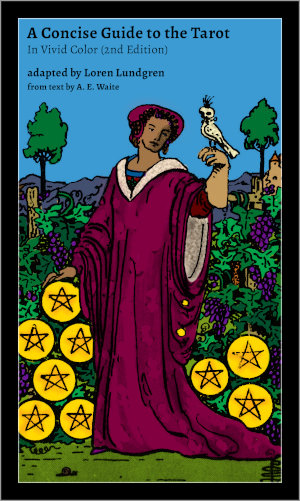Tarot Reading john call me; 10 7 1968
Reading Performed 02/13/2013 at 9:28 AM
Click or scroll down for the meaning of each position and the interpretation of its card.
Visual Layout
The Meanings of these Tarot Cards
This Covers You
This card gives the influence which is affecting the person or matter of inquiry generally, the atmosphere of it in which the other currents work.
The Traitor from the Ancient Tarot of Lombardy Deck
A. E. Waite's Secondary Meanings
The Hanged Man. This is the symbol which is supposed to represent Prudence, and Eliphas Levi says, in his most shallow and plausible manner, that it is the adept bound by his engagements. The figure of a man is suspended head-downwards from a gibbet, to which he is attached by a rope about one of his ankles. The arms are bound behind him, and one leg is crossed over the other. According to another, and indeed the prevailing interpretation, he signifies sacrifice, but all current meanings attributed to this card are cartomancists' intuitions, apart from any real value on the symbolical side. The fortune-tellers of the eighteenth century who circulated Tarots, depict a semi-feminine youth in jerkin, poised erect on one foot and loosely attached to a short stake driven into the ground.
This Crosses You
It shows the nature of the obstacles in the matter. If it is a favourable card, the opposing forces will not be serious, or it may indicate that something good in itself will not be productive of good in the particular connexion.
This Crowns You
It represents (a) the Querent €™s aim or ideal in the matter; (b) the best that can be achieved under the circumstances, but that which has not yet been made actual.
This is Beneath You
It shows the foundation or basis of the matter, that which has already passed into actuality and which the Significator has made his own.
The Papess from the Ancient Tarot of Lombardy Deck
A. E. Waite's Secondary Meanings
The High Priestess, the Pope Joan, or Female Pontiff; early expositors have sought to term this card the Mother, or Pope's Wife, which is opposed to the symbolism. It is sometimes held to represent the Divine Law and the Gnosis, in which case the Priestess corresponds to the idea of the Shekinah. She is the Secret Tradition and the higher sense of the instituted Mysteries.
This is Behind You
It gives the influence that is just passed, or is now passing away.
This is Before You
It shows the influence that is coming into action and will operate in the near future.
Your Self
Signifies the person or thing about which the question has been asked, and shows its position or attitude in the circumstances.
Your House
Your environment and the tendencies at work therein which have an effect on the matter €”for instance, your position in life, the influence of immediate friends, and so forth.
The World from the Ancient Tarot of Lombardy Deck
A. E. Waite's Secondary Meanings
The four living creatures of the Apocalypse and Ezekiel's vision, attributed to the evangelists in Christian symbolism, are grouped about an elliptic garland, as if it were a chain of flowers intended to symbolize all sensible things; within this garland there is the figure of a woman, whom the wind has girt about the loins with a light scarf, and this is all her vesture. She is in the act of dancing, and has a wand in either hand. It is eloquent as an image of the swirl of the sensitive life, of joy attained in the body, of the soul's intoxication in the earthly paradise, but still guarded by the Divine Watchers, as if by the powers and the graces of the Holy Name, Tetragammaton, JVHV--those four ineffable letters which are sometimes attributed to the mystical beasts. Eliphas Levi calls the garland a crown, and reports that the figure represents Truth. Dr. Papus connects it with the Absolute and the realization of the Great Work; for yet others it is a symbol of humanity and the eternal reward of a life that has been spent well. It should be noted that in the four quarters of the garland there are four flowers distinctively marked. According to P. Christian, the garland should be formed of roses, and this is the kind of chain which Eliphas Levi says is less easily broken than a chain of iron. Perhaps by antithesis, but for the same reason, the iron crown of Peter may he more lightly on the heads of sovereign pontiffs than the crown of gold on kings.






















